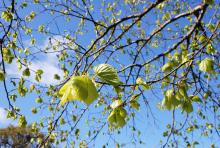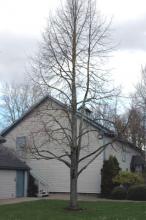Tilia × europaea
Common name:
European Linden
Common Linden
Common Lime
Pronunciation:
TIL-i-a u-roh-PE-ah
Family:
Tiliaceae
Genus:
Synonyms:
T. × vulgaris
Type:
Broadleaf
Native to (or naturalized in) Oregon:
No
- Deciduous tree, to 100 ft (30 m) tall or more in time, conical form, becoming rounded with age. Shoots green, glabrous and with zig-zag habit. Leaves alternate, simple, broadly ovate, 5-9 cm long and 4-8 cm wide, tip abruptly acuminate, base obliquely cordate, margin sharply serrate, dark green and glabrous above, bright green below, tufts of hair in axils of lateral veins; petiole 2.5-5 cm long, glabrous. Flowers pale yellow, about 2 cm across, 5-10 per clusters that are 7-8 cm long, floral bract is 7-11 cm long. Fruit globose ovoid, tomentose, faintly 5-ripped, hard shelled.
- Sun to part shade. Tends to sucker from the base, remove as needed. Susceptible to aphids and red spider mites.
- Hardy to USDA Zone 3 A natural hybrid of between Tilia cordata and Tilia platyphyllos, appears nearer to T. platyphyllos; very common in Europe but not in the U.S. Generally considered to be of less ornamental value than the species often planted in North America, i.e., T. cordata, T. americana, T. euchlora and T. tomentosa. It is also known as T. × vulgaris.
- Portland, OR: Hoyt Arboretum
- Salem, OR: Bush's Pasture Park, south of Art Barn








